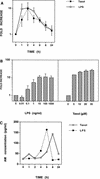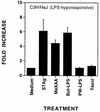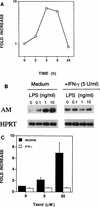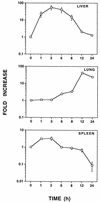Induction of adrenomedullin mRNA and protein by lipopolysaccharide and paclitaxel (Taxol) in murine macrophages
- PMID: 9746563
- PMCID: PMC108574
- DOI: 10.1128/IAI.66.10.4669-4675.1998
Induction of adrenomedullin mRNA and protein by lipopolysaccharide and paclitaxel (Taxol) in murine macrophages
Abstract
Lipopolysaccharide (LPS), a potent inflammatory stimulus derived from the outer membrane of gram-negative bacteria, has been implicated in septic shock. Plasma levels of adrenomedullin (AM), a potent vasorelaxant, are increased in septic shock and possibly contribute to the characteristic hypotension. As macrophages play a central role in the host response to LPS, we studied AM production by LPS-stimulated macrophages. When peritoneal exudate macrophages from C3H/OuJ mice were treated with protein-free LPS (100 ng/ml) or the LPS mimetic paclitaxel (Taxol; 35 microM), an approximately 10-fold increase in steady-state AM mRNA levels was observed, which peaked between 2 and 4 h. A three- to fourfold maximum increase in the levels of immunoreactive AM protein was detected after 6 to 8 h of stimulation. While LPS-hyporesponsive C3H/HeJ macrophages failed to respond to protein-free LPS with an increase in steady-state AM mRNA levels, increased levels were observed after stimulation of these cells with a protein-rich (butanol-extracted) LPS preparation. In addition, increased AM mRNA was observed following treatment of either C3H/OuJ or C3H/HeJ macrophages with soluble Toxoplasma gondii tachyzoite antigen or the synthetic flavone analog 5, 6-dimethylxanthenone-4-acetic acid. Gamma interferon also stimulated C3H/OuJ macrophages to express increased AM mRNA levels yet was inhibitory in the presence of LPS or paclitaxel. In vivo, mice challenged intraperitoneally with 25 microg of LPS exhibited increased AM mRNA levels in the lungs, liver, and spleen; the greatest increase (>50-fold) was observed in the liver and lungs. Thus, AM is produced, by murine macrophages, and furthermore, LPS induces AM mRNA in vivo in a number of tissues. These data support a possible role for AM in the pathophysiology of sepsis and septic shock.
Figures






Similar articles
-
Taxol increases steady-state levels of lipopolysaccharide-inducible genes and protein-tyrosine phosphorylation in murine macrophages.J Immunol. 1992 Oct 1;149(7):2459-65. J Immunol. 1992. PMID: 1356126
-
Microtubule-disrupting agents inhibit nitric oxide production in murine peritoneal macrophages stimulated with lipopolysaccharide or paclitaxel (Taxol).Infect Immun. 1996 Aug;64(8):3379-84. doi: 10.1128/iai.64.8.3379-3384.1996. Infect Immun. 1996. PMID: 8757879 Free PMC article.
-
Lipopolysaccharide increases glucocorticoid receptor expression in murine macrophages. A possible mechanism for glucocorticoid-mediated suppression of endotoxicity.J Immunol. 1992 Dec 15;149(12):4041-7. J Immunol. 1992. PMID: 1360996
-
Lipid A-associated proteins provide an alternate "second signal" in the activation of recombinant interferon-gamma-primed, C3H/HeJ macrophages to a fully tumoricidal state.J Immunol. 1987 Dec 1;139(11):3697-702. J Immunol. 1987. PMID: 3119714
-
Use of a photoactivatable taxol analogue to identify unique cellular targets in murine macrophages: identification of murine CD18 as a major taxol-binding protein and a role for Mac-1 in taxol-induced gene expression.J Immunol. 1999 Jun 15;162(12):7335-42. J Immunol. 1999. PMID: 10358184
Cited by
-
Antimicrobial peptides: natural effectors of the innate immune system.Semin Immunopathol. 2007 Apr;29(1):27-43. doi: 10.1007/s00281-007-0064-5. Semin Immunopathol. 2007. PMID: 17621952 Review.
-
Adrenomedullin and adrenomedullin binding protein-1 protect endothelium-dependent vascular relaxation in sepsis.Mol Med. 2007 Sep-Oct;13(9-10):488-94. doi: 10.2119/2007-00113.Zhou. Mol Med. 2007. PMID: 17932560 Free PMC article.
-
Regulation of inflammatory gene expression in PBMCs by immunostimulatory botanicals.PLoS One. 2010 Sep 3;5(9):e12561. doi: 10.1371/journal.pone.0012561. PLoS One. 2010. PMID: 20838436 Free PMC article.
-
Bacterial lipopolysaccharide induces HIF-1 activation in human monocytes via p44/42 MAPK and NF-kappaB.Biochem J. 2006 Jun 15;396(3):517-27. doi: 10.1042/BJ20051839. Biochem J. 2006. PMID: 16533170 Free PMC article.
-
Exposure to normobaric hypoxia shapes the acute inflammatory response in human whole blood cells in vivo.Pflugers Arch. 2024 Sep;476(9):1369-1381. doi: 10.1007/s00424-024-02969-2. Epub 2024 May 7. Pflugers Arch. 2024. PMID: 38714572 Free PMC article.
References
-
- Abraham E, Wunderink R, Silverman H, Perl T M, Nasraway S, Levy H, Bone R, Wenzel R P, Balk R, Allred R. Efficacy and safety of monoclonal antibody to human tumor necrosis factor alpha in patients with sepsis syndrome. A randomized, controlled, double-blind, multicenter clinical trial. TNF-alpha MAb Sepsis Study Group. JAMA. 1995;273:934–941. - PubMed
-
- Atwell G J, Rewcastle G W, Baguley B C, Denny W A. Potential antitumor agents. 60. Relationships between structure and in vivo colon 38 activity for 5-substituted 9-oxoxanthene-4-acetic acids. J Med Chem. 1990;33:1375–1379. - PubMed
-
- Bogdan C, Ding A. Taxol, a microtubule-stabilizing antineoplastic agent, induces expression of tumor necrosis factor alpha and interleukin-1 in macrophages. J Leukocyte Biol. 1992;52:119–121. - PubMed
-
- Bone R C. A critical evaluation of new agents for the treatment of sepsis. JAMA. 1991;266:1686–1691. - PubMed
Publication types
MeSH terms
Substances
Grants and funding
LinkOut - more resources
Full Text Sources
Other Literature Sources
Research Materials

